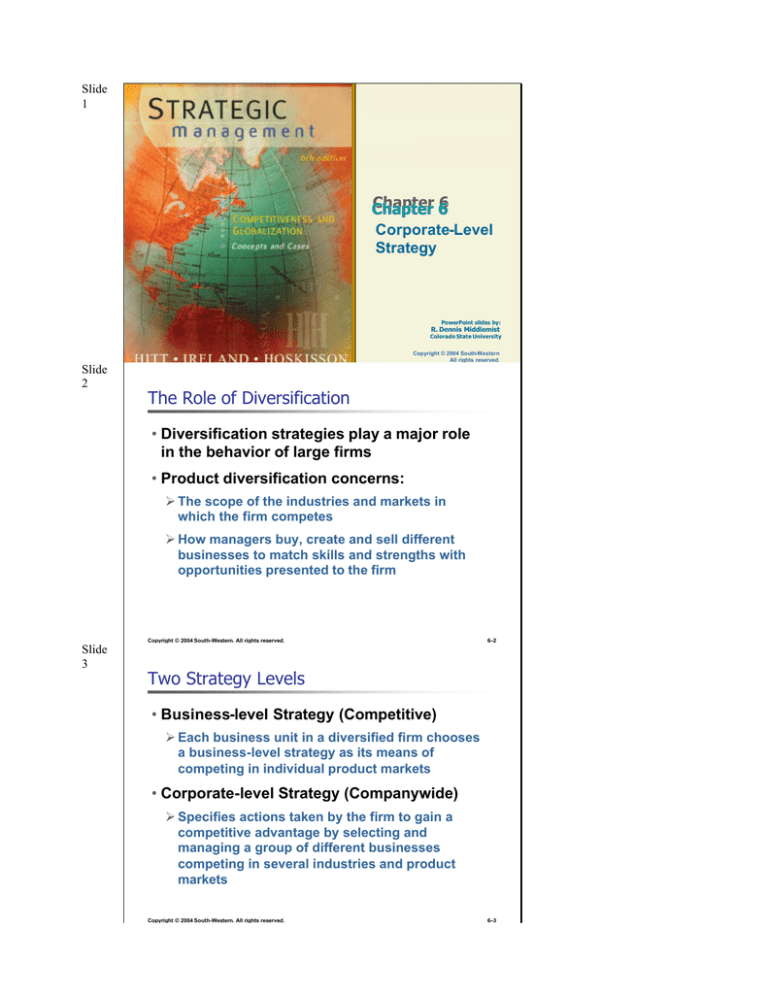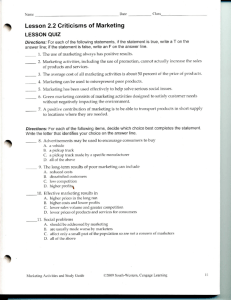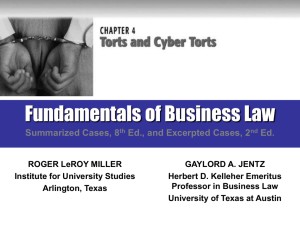
Slide
1
Chapter 6
6
Chapter
Corporate-Level
Strategy
PowerPoint slides by:
R. Dennis Middlemist
Colorado State University
Copyright © 2004 South-Western
All rights reserved.
Slide
2
The Role of Diversification
• Diversification strategies play a major role
in the behavior of large firms
• Product diversification concerns:
Ø The scope of the industries and markets in
which the firm competes
Ø How managers buy, create and sell different
businesses to match skills and strengths with
opportunities presented to the firm
Copyright © 2004 South-Western. All rights reserved.
Slide
3
6–2
Two Strategy Levels
• Business-level Strategy (Competitive)
Ø Each business unit in a diversified firm chooses
a business-level strategy as its means of
competing in individual product markets
• Corporate-level Strategy (Companywide)
Ø Specifies actions taken by the firm to gain a
competitive advantage by selecting and
managing a group of different businesses
competing in several industries and product
markets
Copyright © 2004 South-Western. All rights reserved.
6–3
Slide
4
Corporate-Level Strategy: Key Questions
• Corporate-level Strategy’s Value
Ø The degree to which the businesses in the
portfolio are worth more under the management
of the company than they would be under other
ownership
Ø What businesses should
the firm be in?
Ø How should the corporate
office manage the
group (portfolio)
of businesses?
Business Units
Business Units
Copyright © 2004 South-Western. All rights reserved.
Slide
5
6–4
Balancing Financial Resources: Portfolio Techniques
BCG GrowthShare Matrix
Industry
AttractivenessBusiness Strength
Matrix
Life CycleCompetitive
Strength Matrix
Copyright © 2004 South-Western. All rights reserved.
6–5
BCG Growth-Share Matrix
Cash Generation (Market Share)
High
Cash Use (Growth Rate)
Slide
6
High
Low
Star
Cash Cow
Copyright © 2004 South-Western. All rights reserved.
Low
Problem
Child
Dog
Description of
Dimensions
Market Share: Sales
relative to those of other
competitors in market
(dividing point is usually
selected to have only 2-3
largest competitors in
any market fall into high
market share region)
Growth Rate: Industry
growth rate in constant
dollars (dividing point is
typically GNP’s growth
rate)
6–6
Slide
7
Factors Considered in Constructing an Industry
Attractiveness-Business Strength Matrix
Industry
Industry Attractiveness
Attractiveness Factors
Nature of Competitive
Rivalry
Bargaining Power of
Suppliers/Customers
Threat of Substitutes/
New Entrants
• Number of
• Relative size of
• Technological
competitors
typical players
• Size of competitors
• Numbers of each
• Strength of
• Importance of
competitors’
corporate parents
purchases from or
dales to
• Price wars
maturity/stability
• Diversity of the
market
• Barriers to entry
• Flexibility of
• Ability to vertically
distribution system
integrate
• Competition on
multiple dimensions
Copyright © 2004 South-Western. All rights reserved.
Slide
8
6–7
Factors Considered in Constructing an Industry
Attractiveness-Business Strength Matrix (continued)
Industry
Industry Attractiveness
Attractiveness Factors
Economic Factors
Sociopolitical
Considerations
Financial Norms
• Sales volatility
• Average
• Government
profitability
• Cyclicality of
• Typical leverage
demand
• Market growth
regulation
• Community
support
• Credit practices
• Ethical standards
• Capital intensity
Copyright © 2004 South-Western. All rights reserved.
Slide
9
6–8
Factors Considered in Constructing an Industry
Attractiveness-Business Strength Matrix (continued)
Business Strength Factors
Level of
Differentiation
Cost Position
• Economies of scale
• Manufacturing costs
• Promotion
effectiveness
Response Time
• Manufacturing
flexibility
• Overhead
• Product quality
• Time needed to
• Scrap/waste/rework
• Company image
introduce new
products
• Experience effects
• Patented products
• Delivery times
• Labor rates
• Brand awareness
• Organizational
• Proprietary
flexibility
processes
Copyright © 2004 South-Western. All rights reserved.
6–9
Slide
10
Factors Considered in Constructing an Industry
Attractiveness-Business Strength Matrix (concluded)
Business Strength Factors
Financial Strength
Human Assets
Public Approval
• Solvency
• Turnover
• Goodwill
• Liquidity
• Skill level
• Reputation
• Break-even point
• Relative
• Image
wage/salary
• Cash flows
• Morale
• Profitability
• Managerial
• Growth in
commitment
revenues
• Unionization
Copyright © 2004 South-Western. All rights reserved.
Slide
11
6–10
Industry Attractiveness-Business Strength Matrix
Industry Attractiveness
Description of
Dimensions
High
Medium
Low
Invest
Selective
Growth
Grow or
Let Go
Selective
Growth
Grow or
Let Go
Harvest
Industry Attractiveness:
Business Strength
High
Medium
Low
Grow or
Let Go
Harvest
Divest
Subjective assessment
based on broadest
possible range of
external opportunities
and threats beyond
control of management
Business Strength:
Subject assessment of
how strong a competitive
advantage is created by a
broad range of a firm’s
internal strengths and
weaknesses
Copyright © 2004 South-Western. All rights reserved.
6–11
Market Life Cycle-Competitive Strength Matrix
Stage of Market Life Cycle
Introduction
Competitive Strength
Slide
12
High
Moderate
Growth
Maturity
Low
Copyright © 2004 South-Western. All rights reserved.
Description of
Dimensions
Stage of Market Life
Cycle: See page 184
sh: ely
Pu ressiv
gg
tA
s
e
Inv
:
on y
uti ctivel
a
C ele
S
est
v
In
Decline
Competitive Strength:
er:
ng t
Da arves
H
Overall subjective
rating, based on wide
range of factors
regarding likelihood of
gaining and
maintaining a
competitive advantage
6–12
Slide
13
Contributions of Portfolio Approaches
Convey large amounts of information about diverse
businesses and corporate plans in a simplified format
Illuminate similarities and differences among businesses,
conveying the logic behind corporate strategies for each
business
Simplify priorities for sharing corporate resources across
diverse businesses
Provide a simple prescription of what should be
accomplished - a balanced portfolio of businesses
Copyright © 2004 South-Western. All rights reserved.
Slide
14
6–13
Limitations of Portfolio Approaches
Does not address how value is created across business units
Accurate measurement for matrix classification not as easy as
matrices implied
Underlying assumption about relationship between market share
and profits varies across different industries and market segments
Limited strategic options viewed as basic strategic missions
Portrays notion that firms need to be self-sufficient in capital
Fails to compare competitive advantage a business receives from
being owned by a particular company with costs of owning it 6–14
Copyright © 2004 South-Western. All rights reserved.
Slide
15
Types of Corporate & Grand Strategies
Concentrated Growth
Conglomerate Diversification
Market Development
Turnaround
Product Development
Divestiture
Innovation
Liquidation
Horizontal Integration
Bankruptcy
Vertical Integration
Joint Ventures
Concentric Diversification
Strategic Alliances
Copyright © 2004 South-Western. All rights reserved.
Consortia
6–15
Slide
16
Characteristics of a Concentrated Growth Strategy
• Involves focusing resources on the profitable
growth of a single product, in a single
market, with a single dominant technology
• Rationale - Firm develops and exploits its
expertise in a delimited competitive arena
• Determinants of competitive market success
Ø Ability to assess market needs
Ø Knowledge of buyer behavior
Ø Customer price sensitivity
Ø Effectiveness of promotion
Copyright © 2004 South-Western. All rights reserved.
Slide
17
6–16
Conditions Favoring a Concentrated Growth Strategy
Firm’s industry is resistant to major technological
advancements
Firm’s targeted markets are not product saturated
Firm’s markets are sufficiently distinctive to dissuade
competitors in adjacent markets from entering firm’s segment
Firm’s inputs are stable in price and quantity and available in
amounts and at times needed
Firm’s industry is stable
Firm’s competitive advantages are based on efficient production
or distribution channels
Success of market generalists
Copyright © 2004 South-Western. All rights reserved.
Slide
18
6–17
Strategies of Market and Product Development
• Market development
Ø Consists of marketing present products, often
with only cosmetic modifications, to customers
in related market areas by
v
v
Adding channels of distribution or
Changing content of advertising or promotion
• Product development
Ø Involves substantial modification of existing
products or creation of new but related products
Ø Based on penetrating existing markets by
Incorporating product modifications into existing items
or
v Developing new products connected to existing
products
Copyright © 2004 South-Western.
All rights reserved.
6–18
v
Slide
19
Specific Options for Selected Grand Strategies
Concentration: Increasing use of present products in present markets
1. Increasing present customers’ rate of use:
a. Increasing size of purchase
b. Increasing rate of product obsolescence
c. Advertising other uses
d. Giving price incentives for increased use
2. Attracting competitors’ customers
a. Establishing sharper brand differentiation
b. Increasing promotional effort
c. Initiating price cuts
3. Attracting nonusers to buy the product
a. Inducing trial use through sampling, price incentives, and so
on
b. Pricing up or down
c.© 2004
Advertising
uses
Copyright
South-Western. All new
rights reserved.
6–19
Slide
20
Specific Options for Selected Grand Strategies (continued)
Market Development: Selling present products in new markets
1. Opening additional geographic markets
a. Regional expansion
b. National expansion
c. International expansion
2. Attracting other market segments
a. Developing product versions to appeal to other segments
b. Entering other channels of distribution
c. Advertising in other media
Copyright © 2004 South-Western. All rights reserved.
Slide
21
6–20
Specific Options for Selected Grand Strategies (concluded)
Product Development: Developing new products for present markets
1. Developing new product features
a. Adapt (to other ideas, developments)
b. Modify (change color, motion, sound, odor, form, shape)
c. Magnify (stronger, longer, thicker, extra value)
d. Minify (smaller, shorter, ligher
e. Substitute (other ingredients, process, power)
f. Rearrange (other patterns, layout, sequence, components)
g. Reverse (inside out)
h. Combine (blend, alloy, assortment, ensemble; combine units,
purposes, appeals, ideas)
2. Developing quality variations
3. Developing additional models and sizes (product proliferation)6–21
Copyright © 2004 South-Western. All rights reserved.
Slide
22
Strategies of Horizontal and Vertical Integration
• Horizontal integration
Ø Based on growth via acquisition of one or more
similar firms operating at the same stage of the
production-marketing chain
Ø Involves eliminating competitors, providing
acquiring firm with access to new markets
• Vertical integration
Ø Involves acquiring firms
v
v
To supply acquiring firm with inputs - backward
integration or
Are customers for firm’s outputs - forward integration
Copyright © 2004 South-Western. All rights reserved.
Slide
23
6–22
Vertical and Horizontal Integrations
Textile producer
Textile producer
Shirt manufacturer
Shirt manufacturer
Clothing store
Clothing store
Acquisitions or mergers of suppliers or customer
businesses are vertical integrations
integrations
Acquisitions or mergers of competing
businesses are horizontal integrations
integrations
Copyright © 2004 South-Western. All rights reserved.
Slide
24
6–23
Motivations Related to Diversification Strategies
Increase firm’s stock value
Increase growth rate of firm
Investment is better use of funds than using them for internal
growth
Improve stability of earnings and sales
Balance or fill out product line
Diversify product line
Acquire a needed resource quickly
Achieve tax savings
Increase efficiency and profitability
Copyright © 2004 South-Western. All rights reserved.
6–24
Slide
25
Diversification Strategies
• Concentric diversification
Ø Involves acquisition of businesses related to
acquiring firm in terms of technology, markets, or
products
• Conglomerate diversification
Ø Involves acquisition of a business because it
represents a promising investment opportunity
Ø Primary motivation is profit pattern of venture
• Difference between the approaches
Ø Concentric diversification emphasizes commonality
whereas conglomerate diversification emphasizes
profits for each individual unit
Copyright © 2004 South-Western. All rights reserved.
6–25
Slide
26
Value-creating
Strategies of
Diversification:
Operational and
Corporate
Relatedness
Figure
Figure 6.2
6.2
Copyright © 2004 South-Western. All rights reserved.
Slide
27
6–26
Related Diversification
• Firm creates value by building upon or
extending its:
Ø Resources
Ø Capabilities
Ø Core competencies
• Economies of scope
Ø Cost savings that occur when a firm transfers
capabilities and competencies developed in one
of its businesses to another of its businesses
Copyright © 2004 South-Western. All rights reserved.
6–27
Slide
28
The Curvilinear Relationship between
Diversification and Performance
Figure 6.3
Copyright © 2004 South-Western. All rights reserved.
Slide
29
6–28
Resources and Diversification
• A firm must have both:
Ø Incentives to diversify
Ø Resources required to create value through
diversification
v Cash
v Tangible resources (e.g., plant and equipment)
• Value creation is determined more by
appropriate use of resources than by
incentives to diversify
Copyright © 2004 South-Western. All rights reserved.
Slide
30
6–29
Summary Model of the
Relationship between
Firm Performance and
Diversification
Figure 6.4
SOURCE: R. E. Hoskisson & M. A. Hitt, 1990,
Antecedents and performance outcomes of
diversification: A review and critique of theoretical
perspectives, Journal of Management, 16: 498.
Copyright © 2004 South-Western. All rights reserved.
6–30







